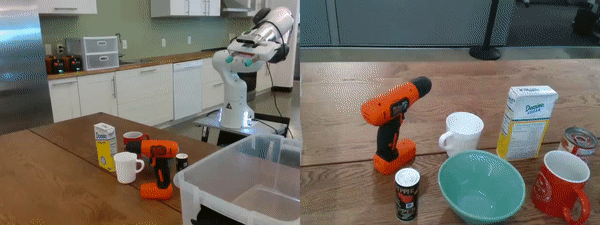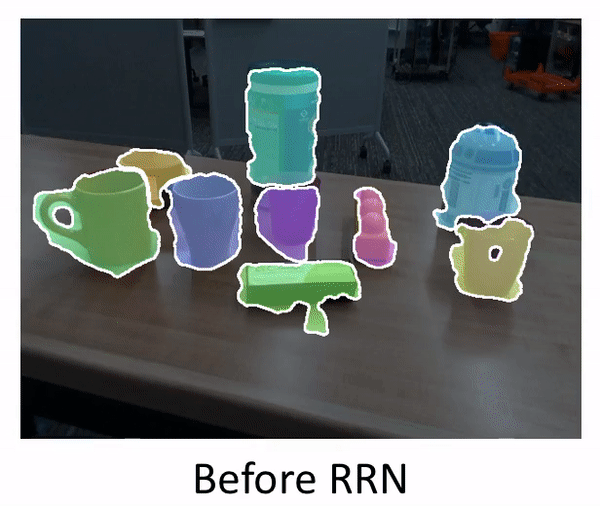This is the implementation of our unseen object instance segmentation network. Our instance segmentation algorithm utilizes a two-stage method to explicitly leverage the strengths of depth and RGB separately for stronger instance segmentation. Surprisingly, our framework is able to learn from synthetic RGB-D data where the RGB is non-photorealistic. Details of the algorithm can be found in our CoRL 2019 paper:
Christopher Xie, Yu Xiang, Arsalan Mousavian, Dieter Fox
The Best of Both Modes: Separately Leveraging RGB and Depth for Unseen Object Instance Segmentation
In Proceedings of Conference on Robot Learning - CoRL, 2019
We highly recommend setting up a virtual environment using Anaconda and pip. Here is an example setup using these tools:
git clone https://github.com/chrisdxie/uois.git
cd uois/
conda env create -f env.ymlIn env.yml, we set cudatoolkit=10.0 by default. Set the CUDA toolkit version to match the native CUDA version (in /usr/local/cuda/), since you must compile the hough voting code with corresponding CUDA compiler (nvcc is not provided with the conda cudatoolkit distribution). This can be checked with: nvcc --version.
Note: As of 9/24/19, it seems that PyTorch is not supported by CUDA 10.1. Please use CUDA <= 10.0. The code has been tested with PyTorch 1.0 and 1.2.
To install the Hough Voting layer (written in CUDA/C++), first install Eigen. Eigen is a C++ template library for linear algebra, consisting ONLY of header files. This can be done from the Github source code and cmake:
git clone https://github.com/eigenteam/eigen-git-mirror.git
cd eigen-git-mirror/
mkdir build/
cd build/
cmake ..
sudo make installIf you do not have sudo access, do not run sudo make install and simply edit setup.py to point to the directory where the Eigen headers live (e.g. <ROOT_DIR>/eigen-git-mirror/).
Note: The code has been tested with commit 4b2884.
Next, run the following line:
conda activate uois
cd <ROOT_DIR>/src/hough_voting/
python setup.py installMake sure that cudatoolkit=... is set to the native CUDA version (in /usr/local/cuda/) which will be used to compile the CUDA code. Otherwise, the compiled CUDA/C++ code may not be compatible with the conda-installed PyTorch.
You can find the models here. We provide a Depth Seeding Network (DSN) model trained on our synthetic Tabletop Object Dataset (TOD), a Region Refinement Network (RRN) model trained on TOD, and an RRN model trained on real data from the Google Open Images Dataset (OID).
See uois_example.ipynb for an example of how to run the network on example images. In order to run this file, Jupyter Notebook must be installed (this is included in env.yml). If you haven't used Jupyter Notebooks before, here is a tutorial to get you up to speed. This repository provides a few images in the example_images folder.
Notes:
- Make sure to activate the Anaconda environment before running jupyter. This can be done with
conda activate uois; jupyter notebook - the notebook should be run in the directory in which it lives (
<ROOT_DIR>), otherwise the filepaths must be manually adjusted. - After downloading and unzipping the models, make sure to update
checkpoint_dirin uois_example.ipynb to point to the directory where the models live.
We provide sample training code in train_DSN.ipynb and train_RRN.ipynb. We have not released our dataset; however, we have included data loading and data augmentation code in this release to help users get started training the network on their data.
Our code is released under GPLv3.
If you find our work helpful in your research, please cite our work.
@inproceedings{xie2019uois,
author = {Christopher Xie and Yu Xiang and Arsalan Mousavian and Dieter Fox},
title = {The Best of Both Modes: Separately Leveraging RGB and Depth for Unseen Object Instance Segmentation},
booktitle = {Conference on Robot Learning (CoRL)},
year = {2019}
}

